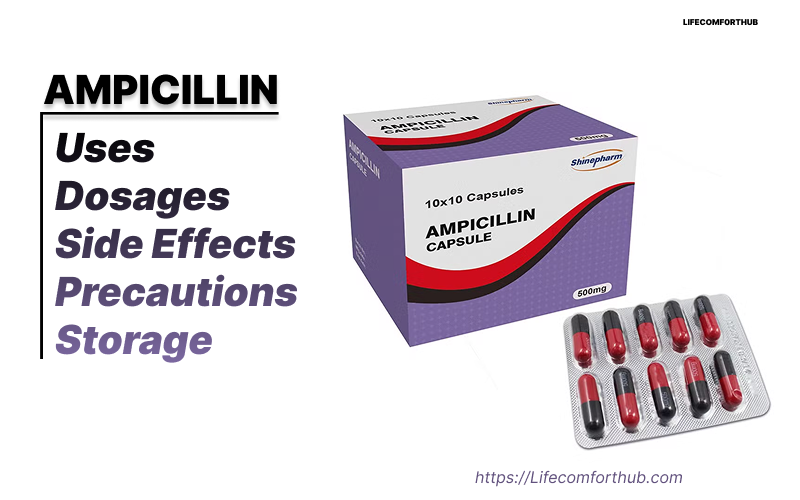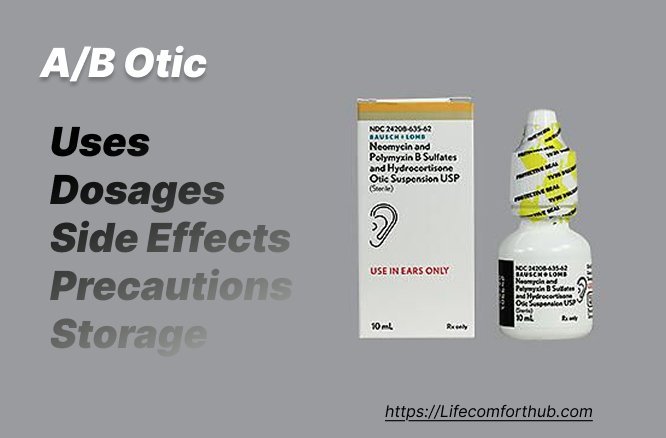Overview
Ampicillin is a broad-spectrum penicillin antibiotic used to treat various bacterial infections, including those affecting the respiratory tract, urinary tract, gastrointestinal system, and central nervous system. It works by preventing bacteria from forming cell walls, ultimately killing them. Available in oral and injectable forms, ampicillin is typically taken on an empty stomach for best absorption. Common side effects include nausea, diarrhea, and rash, while serious allergic reactions are rare but possible. It may interact with other medications, so full disclosure to a healthcare provider is important. Ampicillin should only be used under medical supervision and completed as prescribed.
Contents.
What is Ampicillin | Uses of Ampicillin | Dosages for Ampicillin | Side Effects of Ampicillin | Precautions
What Is Ampicillin?
Ampicillin is a prescription antibiotic that belongs to the penicillin class of drugs. It is used to treat a wide variety of bacterial infections by stopping the growth of bacteria. Ampicillin works by interfering with the bacteria’s ability to form cell walls, which are essential for their survival.
It is considered a broad-spectrum antibiotic, meaning it can target both gram-positive and gram-negative bacteria. Common uses include treatment of infections in the respiratory tract, urinary tract, gastrointestinal tract, and central nervous system, as well as septicemia and endocarditis.
It is available in capsules, oral suspensions, and injectable forms. Ampicillin is typically taken every six hours on an empty stomach to ensure proper absorption. It is not effective against viral infections such as the common cold or flu. Patients with allergies to penicillin or cephalosporin antibiotics should avoid ampicillin, and it should be used only under the guidance of a healthcare provider.
Uses of Ampicillin
Ampicillin is prescribed to treat a range of bacterial infections caused by susceptible organisms. Common uses include:
-
Respiratory tract infections – such as pneumonia, bronchitis, and sinusitis
-
Urinary tract infections (UTIs) – including bladder and kidney infections
-
Gastrointestinal infections – such as salmonella, shigellosis, and typhoid fever
-
Meningitis – particularly due to Haemophilus influenzae, Neisseria meningitidis, or Listeria monocytogenes
-
Septicemia – bacterial infections in the bloodstream
-
Endocarditis – infection of the heart’s inner lining
-
Gonorrhea – in certain cases where other treatments are not suitable
-
Skin and soft tissue infections
-
Ear infections (otitis media)
Ampicillin is also used prophylactically in some cases, such as to prevent bacterial endocarditis in at-risk patients undergoing certain medical or dental procedures. It is important that the specific use is determined by a healthcare professional based on the type of infection and the bacteria involved.
Dosage
Dosage varies based on the type and severity of the infection, as well as patient-specific factors like age and kidney function. Typical adult oral dosages range from 250 mg to 500 mg every 6 hours. For severe infections, higher doses may be administered intravenously. Pediatric dosing is weight-based and should be determined by a healthcare provider.
This drug should be taken on an empty stomach, ideally 30 minutes before or 2 hours after meals, with a full glass of water. Consistency in timing helps maintain effective blood levels of the drug.
What happens if I miss a dose?
Take the medicine as soon as you can, but skip the missed dose if it is almost time for your next dose. Do not take two doses at one time.
Side Effects
Common side effects include:
Nausea
Vomiting
Diarrhea
Rash
Mild skin reactions
Serious side effects, though less common, may include:
Severe allergic reactions (e.g., anaphylaxis)
Clostridium difficile-associated diarrhea
Seizures (especially in patients with renal impairment)
Hematologic changes (e.g., anemia, thrombocytopenia)
If you experience severe side effects or signs of an allergic reaction, seek medical attention immediately.
Precautions
What Should i do Before Taking Ampicillin
Before using this drug, it’s important to take the following precautions to ensure safety and avoid complications:
-
Allergies: Inform your doctor if you’ve ever had an allergic reaction to ampicillin, other penicillins, cephalosporins, or any other medications. Serious allergic reactions like anaphylaxis can occur.
-
Medical History: Tell your healthcare provider if you have kidney disease, asthma, hay fever, or a history of gastrointestinal problems like colitis.
-
Mononucleosis Warning: Avoid using It if you have mononucleosis (“mono”), as it may increase the risk of skin rash.
-
Pregnancy and Breastfeeding: Let your doctor know if you are pregnant or breastfeeding. It is generally considered safe but should only be used if clearly needed.
-
Drug Interactions: Mention all prescription, over-the-counter medications, and supplements you are taking. It may interact with:
-
Oral contraceptives (can reduce their effectiveness)
-
Allopurinol (increased risk of rash)
-
Probenecid (can raise ampicillin levels in the blood)
-
-
Lab Tests: It can affect the results of certain medical tests. Inform lab personnel you are taking it.
Always follow your healthcare provider’s instructions closely when taking this medication.
Storage
Store ampicillin capsules at room temperature, away from moisture and heat. If prescribed the liquid suspension, refrigerate it and discard any unused portion after 14 days. Keep all medications out of reach of children.
Sources
-
DrugBank – Ampicillin
https://go.drugbank.com/drugs/DB00415 -
MedlinePlus – Ampicillin (Oral Route)
https://medlineplus.gov/druginfo/meds/a685002.html -
Cleveland Clinic – Ampicillin Capsules
https://my.clevelandclinic.org/health/drugs/20849-ampicilin-capsules -
RxList – Ampicillin (Generic Drug)
https://www.rxlist.com/ampicilin/generic-drug.htm -
Healthline – Ampicillin Oral Capsule
https://www.healthline.com/health/drugs/ampicilin-oral-capsule -
Drugs.com – Ampicillin
https://www.drugs.com/mtm/ampicilin.html
This article is for informational purposes only and does not substitute professional medical advice. Always consult your healthcare provider for personalized medical guidance.
Read More about Drugs and Diseases



